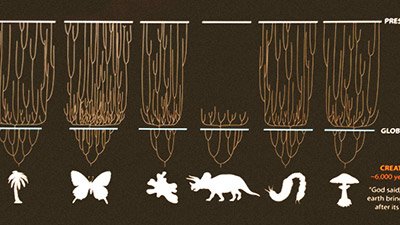Super-Sized Ants
Supersoldier ants said to “illuminate evolutionary processes”
News Source
“Hanging on to ancestral developmental toolkits can be an important way for organisms to evolve new physical traits,” according to McGill University researchers. In their paper published January 6 in Science they write, “We uncovered an ancestral developmental potential to produce a ‘supersoldier’ subcaste [of ants] that has been actualized at least two times independently.”1 They believe parallel evolution of a supersoldier trait occurs when mutations reactivate dormant ancestral genes.
Of the 1100 species of Pheidole ants, only 8 are known to normally produce a super-sized soldier ant. These species are native to the southwestern United States and Mexico where army ants are endemic. While most Pheidole ants evacuate when invaded by army ants, those species with super-soldiers stand their ground as the big soldier ants use their heads to block the doorway and fight off invaders. When McGill’s Dr. Ehab Abouheif discovered similar “monstrous-looking soldiers”2 in a ninth species, Pheidole morrisi, on Long Island, where “there are no hints of army ants anywhere near,”3 he decided to investigate.
Ant larvae develop into various castes in response to nutrition, temperature, and juvenile hormone (JH). Applying methoprene, a JH analog, to larvae at the right time directs larva to grow larger than common workers and become soldier ants.4
Abouheif’s team found that a second application of the hormone could induce supersoldier development in species of the “Super-8” as well as in Pheidole morrisi—the species known to rarely produce supersoldiers. They also induced supersoldier development in two other Pheidole species that have never been known to produce supersoldiers.
Abouheif’s team believes the dormant genetic potential is occasionally activated by mutations. “These ancestral potentials are locked in place, and mutations release them at low frequencies. They are there for natural selection to take hold of,”5 explains Abouheif. “The kind of environmental stressors that evoke this dormant potential are there all the time, so when the need arises natural selection can take hold of the potential and actualize it.”
The team constructed an ant family tree by sampling a five-gene sequence in several species, statistically comparing their differences, and inferring a mutation rate with molecular clock calculations. They believe the common ancestor of all Pheidole ants lived 35 to 60 million years ago. Therefore, Abouheif concludes, “This ancestral potential is locked in place for 35 million years and . . . if you can find it, you can unleash [it]. . . . The fact that you can induce it in all these different species [that don't naturally have that caste], means that one common ancestor of all these species had [supersoldiers].”6
No mechanism for the evolution of any new kind of creature has been demonstrated here, but one of the ways an organism can vary within its created kind has.
“So what we're showing is that environmental stress is important for evolution because it can facilitate the development of novel phenotypes,” Abouheif says. “For the longest time in evolutionary theory, these ancestral traits were thought to go nowhere … the Barnum and Bailey of evolution. So they've been an unappreciated source of evolutionary variation.” However, no mechanism for the evolution of any new kind of creature has been demonstrated here, but one of the ways an organism can vary within its created kind has. By using the word evolution to refer to variation within a created kind as well as evolution of one kind of organism into another and even molecules-to-man evolution, evolutionists can lead the gullible to believe observable speciation and variation prove unobservable (and unbiblical) kinds of evolution.
In this study, Abouheif demonstrated genetic information for this sort of adaptation is present in the genomes of some ants that no longer use the trait. There is no evolutionary mechanism to explain why such an unexpressed trait would remain in the genome for millions of years. (The million-year dates are likely based on the assumption of a constant mutation rate as well as number of shaky statistical games. Read more about molecular clock calculations.) From a biblical perspective, we are not surprised to see the potential for genetic variability within God’s created kinds, including ants, which He created to reproduce after their kind 6,000 years ago.
Further Reading
For More Information: Get Answers
Remember, if you see a news story that might merit some attention, let us know about it! (Note: if the story originates from the Associated Press, FOX News, MSNBC, the New York Times, or another major national media outlet, we will most likely have already heard about it.) And thanks to all of our readers who have submitted great news tips to us. If you didn’t catch all the latest News to Know, why not take a look to see what you’ve missed?
(Please note that links will take you directly to the source. Answers in Genesis is not responsible for content on the websites to which we refer. For more information, please see our Privacy Policy.)
Footnotes
- Rajendhran Rajakumar et al., “Ancestral Developmental Potential Facilitates Parallel Evolution in Ants,” Science 335, no. 6064 (January 6, 2012): 79–82, doi: 10.1126/science.1211451.
- Victoria Gill, “Ants Turned into ‘Supersoldiers’,” BBC Nature, January 5, 2012, http://www.bbc.co.uk/nature/16424096.
- Ed Yong, “Return of the Super Ants,” Nature, January 5, 2012, doi: 10.1038/nature.2012.9746.
- Ibid.
- Ibid.
- Gill, “Ants Turned into ‘Supersoldiers’.”
Recommended Resources

Answers in Genesis is an apologetics ministry, dedicated to helping Christians defend their faith and proclaim the good news of Jesus Christ.
- Customer Service 800.778.3390
- Available Monday–Friday | 9 AM–5 PM ET
- © 2025 Answers in Genesis



